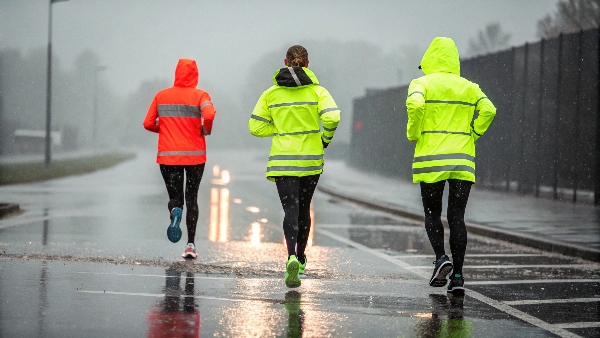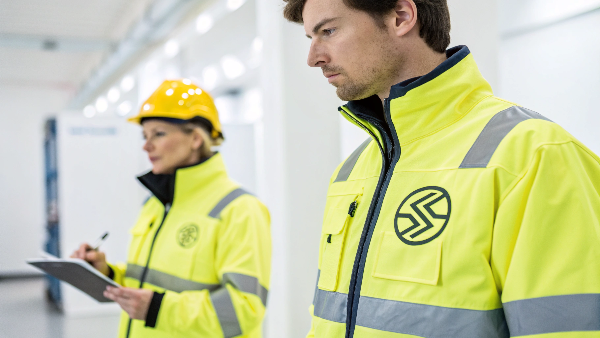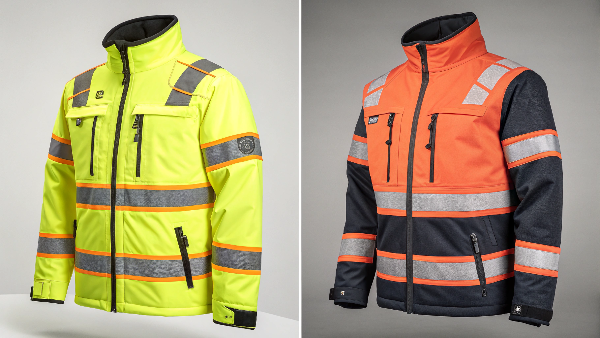When it comes to protective clothing, it’s important to understand the
differences between coveralls and overalls to ensure you stay safe and
comfortable in different work environments. If you’re a tradesperson,
healthcare worker, or work in any industry that requires protective gear,
knowing which type of garment you need can make a big difference. In this
article, we’ll cover the differences between coveralls and overalls, when to
use each, and how they compare to other protective clothing like lab coats.
By the time you finish reading, you’ll have a good understanding of these
essential workwear items.
The Difference Between Coveralls and Overalls
The terms "coverall" and "overall" refer to different types of protective clothing, each with distinct features and uses.
Overalls

Design: Overalls are trousers with a bib, holder, and loose straps that go over the shoulders. They do not cover the arms and are worn over regular clothing.
Usage: Historically associated with farmers and railway workers, overalls are now used by various trades such as painters, carpenters, and factory workers. They are popular in industries where upper-body movement is essential, such as carpentry and joinery.
Material: Typically made from lighter, more breathable materials, overalls are designed for comfort during long periods of wear.
Protection: Overalls offer protection primarily to the lower body and are less suitable for environments requiring full-body protection.
Coveralls

Design: Coveralls are a one-piece garment that covers the entire body, including the arms and legs. Some designs may also cover the head.
Usage: Coveralls are used in various industries, including engineering, fabrication, healthcare, firefighting, and military applications. They are essential in environments where full-body protection is necessary.
Material: Coveralls are made from materials that provide specific protections, such as flame resistance, chemical resistance, thermal insulation, and water resistance.
Protection: Coveralls offer comprehensive protection against hazards such as dirt, grime, chemicals, heat, and fire. They are designed to protect both the worker's body and their clothing underneath.
Key Differences
Coverage: Overalls cover the torso and legs but leave the arms exposed, while coveralls provide full-body coverage, including the arms and sometimes the head.
Protection Level: Coveralls are generally used in more hazardous environments where full-body protection is required, whereas overalls are suitable for less hazardous tasks where upper-body movement is crucial.
Comfort and Material: Overalls are often made from lighter, more breathable materials, making them more comfortable for extended wear. Coveralls, on the other hand, are made from materials that offer specific protections, which may affect breathability and comfort.
In summary, while both overalls and coveralls serve to protect workers, their design and level of protection differ significantly, making each suitable for different types of work environments.
Exploring Further: Lab Coats and Their Role
Having established the fundamental differences between coveralls and overalls, it's essential to explore how other types of protective clothing, such as lab coats, fit into the picture. Lab coats are a staple in laboratory settings and offer a different kind of protection compared to coveralls and overalls.
Lab Coats
Design: Lab coats are typically an open-fronted, knee-length coat with long sleeves. They are designed to be easily removed in case of contamination.
Coverage: Lab coats protect the torso, arms, and upper legs but do not provide full-body coverage.
Purpose: Lab coats provide a barrier against minor splashes and spills in laboratory settings. They are not designed for heavy-duty protection but offer sufficient coverage for everyday lab work.
Material: Lab coats are usually made of cotton, polyester, or polycotton blends. These materials are chosen for their balance of comfort and durability.
Closures: Lab coats typically feature button or snap closures down the front, allowing for quick removal if necessary.
Pockets: Lab coats often have multiple pockets for carrying lab equipment and tools, adding to their functionality.
Unlike coveralls or overalls, lab coats are designed to be easily removed in case of contamination. They offer less comprehensive protection than coveralls but more upper body coverage than overalls. Lab coats are specifically tailored for laboratory environments where full-body protection is not typically necessary but where protection against minor spills and contamination is important.
What is the Difference Between Coveralls and Overalls Describe a Lab Coat?
To further clarify the distinctions between coveralls, overalls, and lab coats, let's recap the main differences:
Coverage:
- Coveralls: Provide full-body coverage, including arms and legs.
- Overalls: Cover the torso and legs but leave the arms exposed.
- Lab Coats: Protect the torso, arms, and upper legs but do not provide full-body coverage.
Design:
- Coveralls: A one-piece garment that zips or snaps up the front.
- Overalls: Consist of pants with a bib and suspender straps.
- Lab Coats: Open-fronted, knee-length coat with long sleeves.
Protection Level:
- Coveralls: Offer comprehensive protection against hazards like chemicals, dirt, and grime.
- Overalls: Provide less protection, especially for the upper body.
- Lab Coats: Offer protection against minor splashes and spills in laboratory settings.
Usage:
- Coveralls: Commonly used in industries requiring full-body protection like engineering, fabrication, and healthcare.
- Overalls: Popular in trades like carpentry and painting where upper body mobility is important.
- Lab Coats: Specifically used in laboratory environments.
Material:
- Coveralls: Often made of protective materials for specific hazards.
- Overalls: Typically made of lighter, more breathable fabrics.
- Lab Coats: Made of cotton, polyester, or polycotton blends.
What Are Overalls Called in the UK?
In the United Kingdom, what Americans commonly refer to as "overalls" are typically called "dungarees."
Key Points:
- The term "dungarees" is the British English equivalent for what Americans call "overalls."
- Both terms refer to the same type of garment: trousers with a bib and straps that go over the shoulders.
- The garment is described as "full-length trousers with a classic bib sewn as the top, which is usually secured by braces."
- In British English, "dungarees" and "overalls" can be used interchangeably to describe this type of clothing.
- These garments are also sometimes referred to as "bib-and-brace overalls."
- It's worth noting that while "dungarees" is the more common term in the UK, some British people may also understand and use the term "overalls," especially in work-related contexts. The use of either term would generally be understood in the UK, but "dungarees" is considered the more typically British term for this type of garment.
What's the Difference Between Overalls and Bibs?
The main differences between overalls and bibs are:
Coverage:
- Overalls: Typically cover the entire legs and torso up to the chest, with straps over the shoulders.
- Bibs: Generally cover just the front of the torso and upper legs, with straps over the shoulders.
Design:
- Overalls: Full-length trousers with an attached bib and suspender straps.
- Bibs: More like an apron with a bib front and straps, often leaving the back mostly exposed.
Usage:
- Overalls: Commonly worn as protective workwear or casual fashion.
- Bibs: Often used for specific activities like skiing, fishing, or as protective gear in certain industries.
Material:
- Overalls: Typically made of durable materials like denim, canvas, or heavy-duty fabrics.
- Bibs: Can be made from a variety of materials depending on their purpose, from waterproof fabrics for outdoor activities to lighter materials for casual wear.
Functionality:
- Overalls: Provide full lower body coverage and protection.
- Bibs: Primarily protect the front of the body and are often designed for specific activities or environments.
Wear:
- Overalls: Generally worn as the outer layer, sometimes over other clothing.
- Bibs: Usually worn over other clothing as an additional protective or functional layer.
It's worth noting that the terms "overalls" and "bibs" are sometimes used interchangeably, especially in different regions or contexts. However, these are the general distinctions between the two types of garments.
What Are Overalls Called Now?
Based on the search results and current usage, overalls are still commonly referred to by several names, depending on the region and context:
Overalls: This remains the most common term in American English for the full-length trousers with a bib and straps over the shoulders.
Dungarees: This is the typical British English term for what Americans call overalls. The terms "overalls" and "dungarees" can be used interchangeably in the UK.
Bib-and-brace overalls: This is another term used to describe the same garment, emphasizing the bib front and the straps (braces) that go over the shoulders.
Bib overalls: A variation that specifically highlights the bib feature.
Jumpsuit: While not exactly the same, this term is sometimes used for similar one-piece garments, especially in fashion contexts.
It's worth noting that the terminology can vary slightly depending on the specific design, material, and intended use. For example, shorter versions might be called "shortalls," and there are variations like "salopettes" for specific activities such as skiing or sailing.
In contemporary fashion, these garments have seen a resurgence in popularity, and brands may use trendy or marketing-specific terms to describe their versions of overalls. However, the traditional terms "overalls" and "dungarees" remain widely recognized and used.
What Are Overalls Called in America?
In America, the garment you're asking about is most commonly called "overalls" or "bib overalls." Here are the key points about what overalls are called in America:
Overalls: This is the most common and widely used term in American English for the full-length trousers with a bib and straps over the shoulders.
Bib overalls: This term is also frequently used, emphasizing the bib feature on the front of the garment.
Dungarees: While this term is more common in British English, some Americans may use it interchangeably with overalls, especially in certain regions or contexts.
Coveralls: This term is sometimes used, although it typically refers to a one-piece garment that covers the entire body, including the arms.
Jumpsuit: In fashion contexts, this term might be used for similar one-piece garments, though it usually implies a different style than traditional workwear overalls.
It's worth noting that "overalls" remains the most widely recognized and used term in American English for this type of garment, especially when referring to the traditional workwear style. The other terms may be used in specific contexts or by certain demographics, but "overalls" is the most universally understood term across the United States.
Are Overalls American or British?
Overalls are neither exclusively American nor British - they are used and recognized in both countries, but with some differences in terminology:
In American English:
- The term "overalls" is most commonly used to describe the garment with full-length trousers and a bib front with straps over the shoulders.
- "Bib overalls" is also frequently used to emphasize the bib feature.
In British English:
- The same garment is typically called "dungarees".
- However, the term "overalls" is also understood and sometimes used interchangeably with "dungarees".
Historical Origin:
- Overalls were invented in the mid to late 1890s by Levi Strauss & Co. in the United States, originally as protective workwear.
Usage in Both Countries:
- Both Americans and British people use and recognize this type of garment, though it may have different connotations or uses in each culture.
Global Recognition:
- The garment style is known worldwide, with various names in different languages and cultures.
In summary, while overalls have American origins, they are not exclusive to American culture. The main difference lies in the terminology used to describe them in American versus British English. Both cultures have adopted and adapted the garment for various uses, from workwear to fashion items.
What Do Australians Call Overalls?
Based on the search results and additional context, here are the key points about what overalls are called in Australia:
Overalls: This is the most common term used in Australia for the full-length trousers with a bib and straps over the shoulders.
Bib and Brace Overalls: This term is also used in Australia to describe the same garment, emphasizing the bib front and straps.
Not Dungarees: Unlike in the UK, the term "dungarees" is not commonly used in Australia to refer to overalls. One Australian commenter specifically noted: "I am Australian and I don't think the word 'dungarees' is used much here."
Regional Variations: As with many terms, there may be some regional variations in Australia, but "overalls" appears to be the most widely recognized term.
Distinction from Other Garments: Australians generally distinguish overalls from other types of workwear like coveralls or boiler suits.
In summary, Australians primarily use the term "overalls" or sometimes "bib and brace overalls" to describe the garment known as overalls in American English. The term "dungarees" is not commonly used in Australia for this garment, contrary to British usage.
What is a Coverall Also Known As?
A coverall is also known by several other names:
Boilersuit: This term is commonly used in British English to refer to the same one-piece protective garment.
Jumpsuit: While not exactly the same, this term is sometimes used interchangeably, especially in fashion contexts.
Overalls: In British English, the term "overalls" is used to describe what Americans call coveralls.
Protective Suit: This is a more general term that can include coveralls among other types of protective clothing.
Work Suit: A generic term sometimes used to describe coveralls in work contexts.
Dust Coat or Duster: These terms can refer to similar protective garments, though they may have slight design differences.
Smock: While typically referring to a looser, shorter garment, this term is sometimes used for similar protective clothing.
The key features of a coverall, regardless of the name used, are that it's a loose-fitting, one-piece garment that covers both the upper and lower body, often including the arms. It's typically worn over other clothing to protect the wearer during dirty or hazardous work.
Conclusion
In conclusion, it’s important to understand the differences between
coveralls and overalls, as well as other protective clothing like lab coats,
to make sure you choose the right gear for your work environment. Overalls,
with their bib and strap design, are comfortable and allow for mobility,
making them ideal for trades that require a lot of upper-body movement.
Coveralls provide full-body protection and are suitable for hazardous
environments. Lab coats are designed for laboratory settings and offer
protection against minor spills and contamination.
The names for these garments can vary by region. In the UK, overalls are
called “dungarees,” while in Australia and the US, they’re called
“overalls.” Coveralls are also known as “boilersuits” or “protective suits”
in different contexts.
By understanding these differences, you can make informed decisions
about the protective clothing you need to stay safe, comfortable, and
productive in your work. Whether you’re putting on a pair of overalls for a
carpentry project, slipping into coveralls for a hazardous task, or wearing a
lab coat in a scientific setting, each garment serves a specific purpose
designed to meet the needs of different professions.



